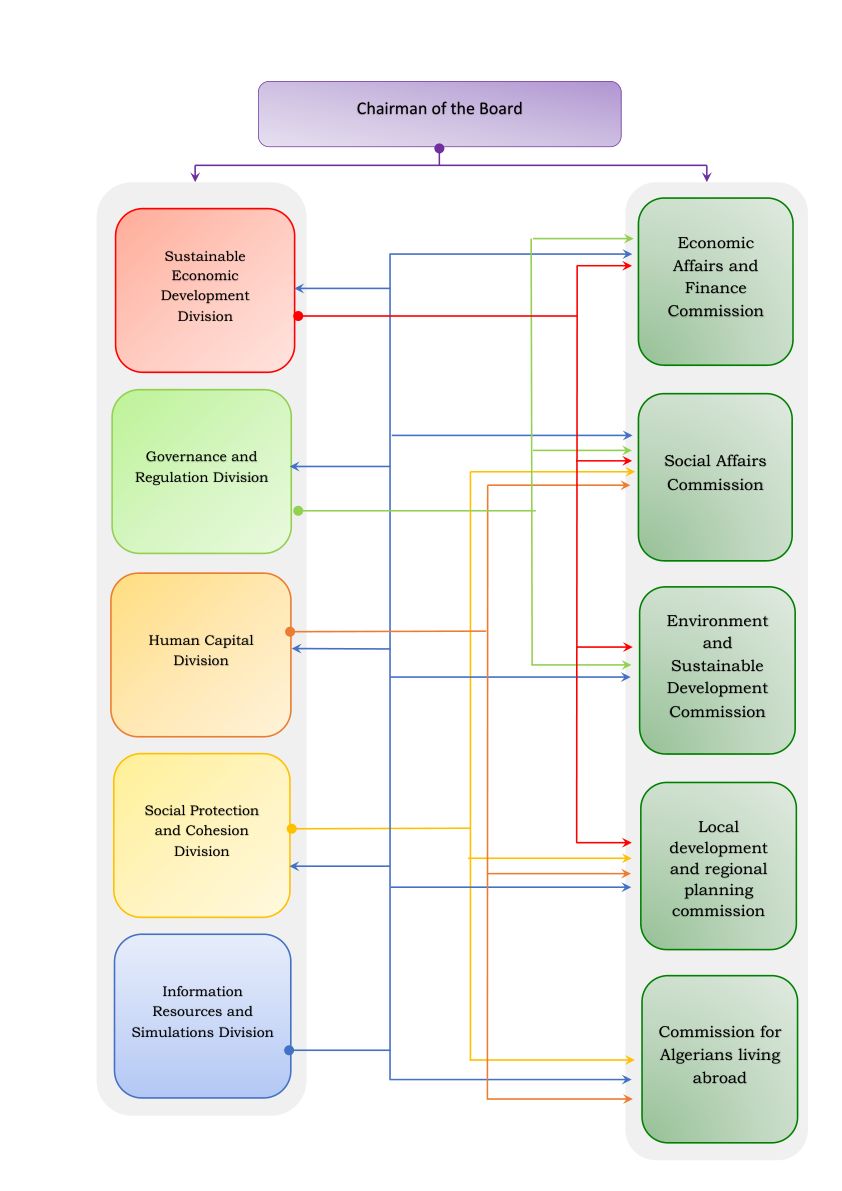The Council consists of four bodies:
- The President
- The Plenary Assembly
- The Bureau
- The Permanent Committees
The Council is equipped with administrative and technical services, placed under the authority of the Council President. The administration of the Council is led by a Secretary-General.
1. The President of the Concil
The President of the Council, appointed by presidential decree, is responsible for:
- Presiding over plenary sessions and Bureau meetings and guiding their work;
- Assigning tasks to Council members and defining those of the two Vice-Presidents;
- Setting the agenda for plenary and Bureau meetings;
- Submitting draft programs and activity reports to the Plenary Assembly for approval;
- Appointing staff for whom no other appointment procedure is specified;
- Exercising hierarchical authority over all Council personnel;
- Sending the annual activity report, as well as all reports, recommendations, opinions, and studies produced by the Council, to the President of the Republic;
- Returning all such reports, recommendations, opinions, and studies to the referring authorities mentioned in Article 4 above;
- Forwarding to the Prime Minister any reports, recommendations, opinions, and studies resulting from the Council’s self-referral;
- Representing the Council internationally ;
- Ensuring compliance with the Council’s internal regulations;
- Acting on behalf of the Council in all civil matters;
- Preparing and executing the Council’s budget in accordance with applicable laws and regulations;
2. The Plenary Assembly
The Plenary Assembly comprises 200 members and is tasked with:
- Reviewing and adopting the internal regulations and the ethics and deontology charter proposed by the Bureau;
- Examining and approving its activity program;
- Reviewing and adopting reports from the Permanent Committees;
- Examining and approving its annual activity program;
- Considering all reports, recommendations, opinions, and studies submitted to it;
- Electing members to the Permanent Committees;
The deliberations of the plenary assembly can only be validated in the presence of the majority of its members. If the quorum is not reached, the President of the Council convenes a new plenary assembly within a period not exceeding fifteen (15) days, regardless of the number of members present. The adoption of the Council's various documents in the plenary assembly is done by a majority vote of the members present. In case of a tie, the vote of the President of the Council prevails. The right to vote is personal and cannot be delegated. The recommendations, opinions, reports, and studies of the Council must mention, if applicable, the positions and/or reservations of the different parties, particularly minority viewpoints. The plenary assembly of the Council meets, in regular session, four (4) times a year, upon the convocation of its President. The plenary assembly may convene in extraordinary sessions, upon the President's convocation or at the request of two-thirds (2/3) of its members. .
3. The Bureau
It is presided over by the President of the Council and is composed of:
- The heads of the five Permanent Committees (see Section 4)
- Two representatives of the economic, social and environmental sectors, elected by their peers;
- One representative of civil society, elected by civil society members
- One representative of qualified personalities, elected by that group
- One representative of State administrations and institutions, elected by their peers
The members of the board are in office for the duration of their respective mandates.
The office is responsible for:
- Draft the Council’s internal regulations and ethics charter for Plenary approval;
- Prepare and oversee the activity program once adopted by the Plenary Assembly
- Coordinate and monitor the work of the various Committees
- Compile the annual report and submit it to the Plenary Assembly
- Appoint one or more Committees to issue opinions, draft reports or make recommendations
- Organize reconciliation efforts requested by the President of the Republic or the Government;
- Assess the feasibility of proposing, in the interest of safeguarding the public good, maintaining public order and ensuring the continuity of public service, a process of alignment and conciliation for the parties involved in social disputes and inform the Government accordingly.
The Bureau members shall elect from among themselves two vice-presidents, in succession: the First Vice-President and the Second Vice-President.
A vice-president is elected from among the members of the board by the members themselves. The Secretary-General of the Council or their representative is responsible for the secretarial duties of the Council's board meetings.
4. The Permanent Committees
The Council shall establish five (5) permanent committees:
- the Committee on Economic and Financial Affairs;
- the Committee on Social Affairs;
- the Committee on Environment and Sustainable Development;
- the Committee on Local Development and Territory Planning;
- the Committee on Algerians Residing Abroad.
The procedures for electing members to the commissions are determined by the internal regulations of the Council.
The permanent committees consist of at least:
- four (4) representatives from the economic, social, and environmental sectors;
- four (4) representatives from civil society;
- three (3) representatives selected on a personal capacity (intuitu personae);
- four (4) representatives from State administrations and institutions.
A member of the Council may not be a part of more than two (2) permanent committees.
The number of members comprising each committee must not exceed fifteen (15) members.
The Committees, each in their respective area, prepare assessments, reports, and studies on the issues and challenges submitted to them by the board. They also provide opinions on the ongoing or proposed programs and actions of the Government, along with proposals and recommendations.
In addition to the permanent committees, the Council may establish, as necessary, sub-committees and ad hoc committees upon the decision of its president, its board, or upon the proposal of at least one-third (1/3) of its members.
10/03/2022
